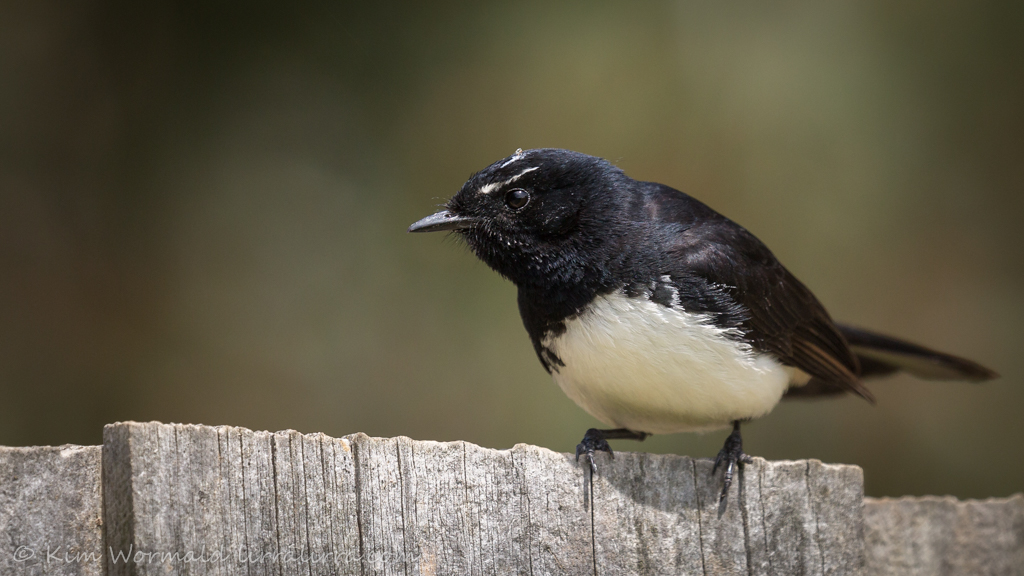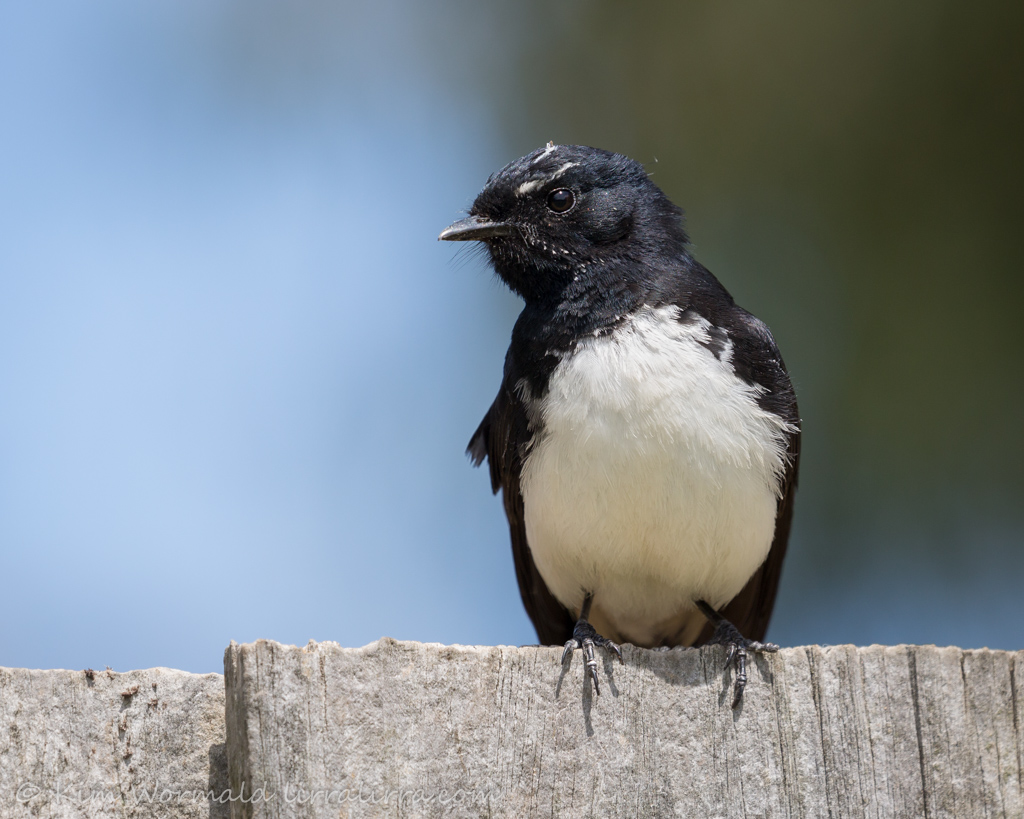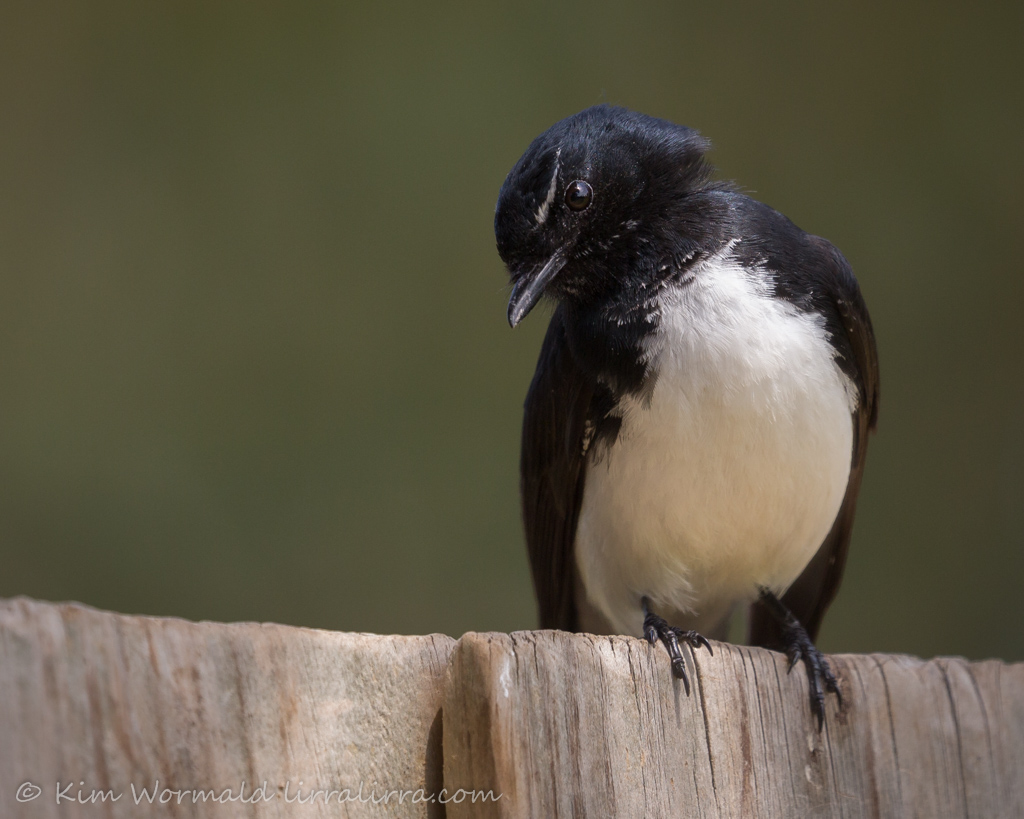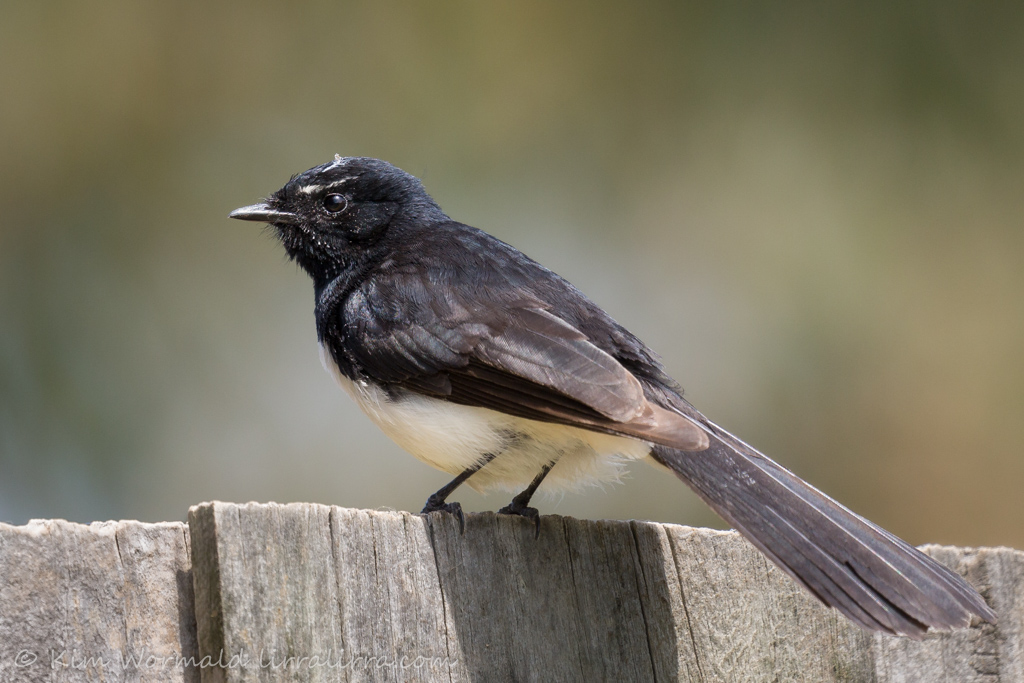Willie Wagtails are ubiquitous across mainland Australia and happily wag their tails in suburban gardens, paddocks and the middle of deserts.
Willie Wagtail (Rhipidura leucophrys)
Canon 5DIII, Canon 100-400L IS USM II, 1/1250, f/6.3, ISO 400, focal length 371mm
This week’s series of images are of a pair of Willie Wagtails that kept hopping onto a tall fence that they used as a vantage point for hunting. The sun was too high in the sky for good lighting but I had my camera with me and took a few shots that I like more than I expected to.
The wagtails perched on different parts of the fence where the background included a tree, a building, clear sky and some shrubs. I’m always aware of backgrounds when taking images but I don’t usually have so many options, or birds that keep returning. I generally prefer backgrounds that are out of focus with a pleasant bokeh (aesthetic blur) that enables the bird to stand out rather than being lost in a busy muddle. Though sometimes the busy muddle makes the image, as shown in an early post, Colourful Camouflage, where Rainbow Lorikeets are lost among the eucalypt blossoms.
Willie Wagtail (Rhipidura leucophrys)
Canon 5DIII, Canon 100-400L IS USM II, 1/800, f/7.1, ISO 800, focal length 400mm
The quality of the bokeh depends on several factors including the lens, the distance the camera is from the subject, the distance the background is from the subject and the aperture chosen. I haven’t included any images that have a totally blue background as the sky was cloudless and uninteresting; the greenery behind the wagtail in the image above lifts the background enough to provide a sense of place. Nor have I included images with the lines and highlights of the building as a background.
Willie Wagtail (Rhipidura leucophrys)
Canon 5DIII, Canon 100-400L IS USM II, 1/800, f/5.6, ISO 400, focal length 400mm
Wouldn’t it be neat to be able to see with their eyes for a moment? Or the eyes of a raptor? I spent some time today peering at grass to see if i could find insects, I saw one that would have been a tasty morsel for a Willie Wagtail but these birds see numerous insects on the ground and in the air, and often from significant distances. The background in the image above is smooth as the bushes were further away from the bird. The wide open aperture (f/5.6) pinpoints the area of interest and, in this case, renders some the fence out of focus at each edge of the image along with some ‘less important’ parts of the bird. The gap in the feathers at the back of the wagtail’s neck give an indication of how tiny the actual bird is beneath its mantle of feathers; Willie Wagtails are about 20cm in length including their long tail, and they weigh just 20g.
Willie Wagtail (Rhipidura leucophrys)
Canon 5DIII, Canon 100-400L IS USM II, 1/800, f/5.6, ISO 400, focal length 400mm
We call Willie Wagtails ‘black and white’ but those soft, warm browns are quite beautiful. Again, by using an f-stop of 5.6 the depth of field (area in focus) is very narrow which blurs the background nicely but also means the the tip of the bird’s tail is slightly blurred, though this could also be caused by movement as a shutter speed of 1/800 second may have been too slow to freeze the movement of a wagging wagtail. I don’t find the tail softness distracting as the tail leads the eye towards to the main part of the bird which is well focused.
Willie Wagtail (Rhipidura leucophrys)
Canon 5DIII, Canon 100-400L IS USM II, 1/1250, f/7.1, ISO 800, focal length 400mm
Some people particularly like backgrounds with circles of light as shown above, though the circles can be far more defined that these. One of the wagtails came to the fence almost as if it was showing me the collection of bugs it had ready to feed the fledglings that were sitting in the tree. I didn’t take images of the fledglings as I didn’t want to disturb them. Willie Wagtails generally raise three nestlings per clutch and can raise up to four clutches in a good season. I wonder if the ant on the fence has any idea how close it is to danger.
 Michael Leunig cartoon (used with permission)
Michael Leunig cartoon (used with permission)
Michael Leunig creates many insightful cartoons and kindly allowed me to share this this gem on lirralirra.
I’d intended to have this year’s calendar ready during September, whoops. In past years I’ve donated profits to the Friends of the Helmeted Honeyeater, this year profits will go to the Coalition Against Duck Shooting – the thought of donating to CADS will serve as inspiration to work on the calendar as soon as I can.
Happy birding, Kim
~ Thank you for visiting and commenting
~ If you would like a weekly email letting you know that lirralirra has been updated please use the ‘subscribe’ box above right






Ah Leunig!
IMHO the split backgrounds in the second and last shots are my favorites. I think they indeed bring the eye to the wagtail more than say the solid color (especially the green). I really love that last shot but the expression in #3 is lovely. But I’m a sucker for a cocked head! LOL Really you can’t go wrong with any of your pictures my dear!
Hi Sherry, I’ve been scrolling back and forth checking out your comments – thank you! It’s so interesting to hear what appeals to different viewers. A cocked head is a winner with dog shots too, there is something very appealing about the pose, I wonder why.
Hi Kim,
lovely photos of an interesting little bird.
Thank you Carole. They’re such iconic little birds
Such sweet little birds and finished off with a wonderful cartoon! CADS are fantastic recipients for your donations and you did such great work documenting and helping with their campaign this year
I’m glad you like the wagtails and cartoon, and you did great work with CADS! Thank you for inspiring me to join you. Let’s hope no season is called this year.
Beautiful as usual Kim.
Good idea with the calendar. I might do the same. I can do calendars with my Red Bubble account I think.
Yes you can use Redbubble for calendars; they’re expensive but I’ve been happy with the quality. They make good gifts and are a lovely record too.
Beautiful, lovely work. So well-seen, so well realized. Your love of the birds (& of Leunig) shines through
Thanks for you kind comment Pauli, really appreciated.
Two very separate joys in this post. I adore Willie Wagtails – and Michael Leunig. Thank you. I much prefer his work to that of his sister, who is frequently very dark and doesn’t have his whimsical charm.
I’ll check out his sister’s work, you’ve made me curious EC.